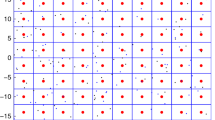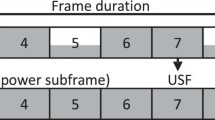Abstract
In this paper, we investigate an interplay between the hexagonal network models and the root system of a particular class of rank two Lie algebras, called \(G_2\). In this work, we show that the hexagonal cells explored in telecommunication systems are associated with the nonzero roots of \(G_2\)-generalized Lie algebras. More precisely, the \(G_2\) hexagons are analyzed in some details and they are shown to be linked to the equation defining the co-channel reuse ratio. Using root systems and Dynkin diagrams technics, we reveal that such a equation can be converted into an algebraic relation in terms of the two simple roots describing \(G_2\)-generalized Lie algebras.




Similar content being viewed by others
References
Alouini, M., & Goldsmith, A. J. (1999). Area spectral efficiency of cellular mobile radio systems. IEEE Transactions on Vehicular Technology, 48(4), 1047–1066.
Althaus, E., Calinescu, G., Mandoiu, I. I., Prasad, S., Tchervenski, N., & Zelikovsky, A. (2006). Power efficient range assignment for symmetric connectivity in static ad hoc wireless networks. Wireless Networks, 12, 287–299.
Anang, K. A., Rapajic, P. B., Wu, R., Bello, L., & Eneh, T. I. (2012). Cellular system information capacity change at higher frequencies due to propagation loss and system parameters. Progress in Electromagnetics Research B, 44, 191–221.
Alam, S. M., & Haas, Z. J. (2006). Coverage and connectivity in three-dimensional networks. In Proceedings of the twelfth annual international conference on mobile computing and networking (ACM Mobicom06), September 23–29, 2006, Los Angeles, CA, USA.
Burde, D., & Dekimpe, K. (2006). Novikov structures on solvable Lie algebras. Journal of Geometry and Physics, 56(9), 1837–1855.
Bai, X., Kumar, S., Xuan, D., Yun, Z., & Lai, T. H. (2006). Deploying wireless sensors to achieve both coverage and connectivity. In Proceedings of the 7th ACM international symposium on mobile ad hoc networking and computing (MobiHoc06) (pp. 131–142), May 22–25, 2006, Florence, Italy.
Belhaj, A. (2012). Symétrie en Physiques: Algèbres de Lie, Théorie des groupes et Représentations, arXiv:1205.3335.
Belhaj, A., Boya, L. J., & Segui, A. (2013). On hexagonal structures in higher dimensional theories. International Journal of Theoretical Physics, 52(1), 130–136.
Rubio, R. (2013). \(B_n\)-generalized geometry and \(G_2^2\)-structures. Journal of Geometry and Physics, 73, 150–156.
Belhaj, A. (2002). Manifolds of G2 holonomy from N = 4 sigma model. Journal of Physics: A Mathematical and General, 35(42), 8903–8912.
Humphreys, J. E. (1978). Introduction to Lie algebras and representation theory. New York: Sauteur-Verlag.
Huang, K., & Andrews, J. G. (2011). A stochastic-geometry approach to coverage in cellular networks with multi-cell cooperation. In Global telecommunications conference (pp 1–5).
Huang, C. F., Tseng, Y. C., & Wu, H. L. (2007). Distributed protocols for ensuring both coverage and connectivity of a wireless sensor network. ACM Transactions on Sensor Networks, 3, 1–24.
Huang, C., & Tseng, Y. (2005). The coverage problem in a wireless sensor network, In Proceedings of the international conference on wireless sensor networks and applications (WSNA) (pp. 519–528).
Iyengar, R., Kar, K., & Mukherjee, S. (2005). Low-coordination topologies for redundancy in sensor networks. In Proceedings of the 7th ACM international symposium on Mobile ad hoc networking and computing (MobiHoc05) (pp. 332–342), May, 2005, Urbana-Champaign, IL, USA.
Ghosh, A., & Das, S. K. (2008). Coverage and connectivity issues in wireless sensor networks: A survey. Pervasive and Mobile Computing, 4, 303–334.
Kochan, D. (2004). Grassmann electrodynamics and general relativity. Journal Geometry and Physics, 51(2), 196–210.
Katiyar, S., Jain, R. K., & Agrawal, N. K. (2012). R.F. Pollution reduction in cellular communication. International Journal of Scientific & Engineering Research, 3(3), 1–6.
Kershner, R. (1939). The number of circles covering a set. American Journal of Mathematics, 61(3), 665–671.
Kumar, S., Lai, T. H., & Balogh, J. (2004). On k-coverage in a mostly sleeping sensor network. In Proceedings of the 10th annual international conference on Mobile computing and networking (pp.144–158), Philadelphia, PA, USA.
Madhusudhanan, P., Restrepo, J. G., Liu, Y., Brown, T. X., & Baker, K. R. (2011). Multi-tier network performance analysis using a shotgun cellular system. In IEEE Globecom (pp. 1–6).
Megerian, S., Koushanfar, F., Qu, G., Veltri, G., & Potkonjak, M. (2002). Exposure in wireless sensor networks: Theory and practical solutions. Wireless Networks, 8, 443–454.
Meguerdichian, S., Koushanfar, F., Potkonjak, M., & Srivastava, M. (2001). Coverage problems in wireless ad-hoc sensor networks. In Proceedings of the 20th IEEE international conference on Computer communications (INFOCOM01) (pp. 115–121), April, 2001, Anchorage, AK.
Slate, P. B. (2005). Silver mean conjectures for 15-d volumes and 14-d hyperareas of the separable two-qubit systems. Journal Geometry and Physics, 53, 74–97.
Steane, A. M. (2002). Quantum computer architecture for fast entropy extraction. Quantum Information and Computation, 2(4), 297–306.
Stravroulakis, P. (2003). Interference analysis and reduction for wireless system. Norwood: Artech House.
Stojanovic, M. (2008). Design and capacity analysis of cellular-type underwater acoustic networks. IEEE Journal of Oceanic Engineering, 33(2), 171–181.
Stojanovic, M., & Peleato, B. M. (2008). A channel sharing scheme for underwater cellular networks. Sea Technology, 49(5), 39–42.
Shakkottai, S., Srikant, R., & Shroff, N. B. (2005). Unreliable sensor grids: Coverage, connectivity and diameter. Ad Hoc Networks, 3, 702–716.
Veltri, G., Huang, Q., Qu, G., & Potkonjak, M. (2003). Minimal and maximal exposure path algorithms for wireless embedded sensor networks. In Proceedings of the 1st international conference on Embedded networked sensor systems (Sensys03) (pp. 40–50), November, Los Angeles, CA.
Wang, Y., Hu, C., & Tseng, Y. (2005). Efficient deployment algorithms for ensuring coverage and connectivity of wireless sensor networks. In Proceedings of the first international conference on wireless internet (WICON) (pp. 114–121).
Wang, X., Xing, G., Zhang, Y., Lu, C., Pless, R., & Gill, C. (2003). Integrated coverage and connectivity configuration in wireless sensor networks. In Proceedings of the 1st international conference on embedded networked sensor systems (Sensys03) (pp. 28–39), November, Los Angeles, CA.
Younis, M., & Akkaya, K. (2008). Strategies and techniques for node placement in wireless sensor networks: A survey. Ad Hoc Networks, 6, 621–655.
Zhang, H., & Hou, J. C. (2005). Maintaining sensing coverage and connectivity in large sensor networks. Ad Hoc and Sensor Wireless Networks, 1(1–2), 125–157.
Zhang, H., & Hou, J. (2004). On deriving the upper bound of \(\alpha\)-lifetime for large sensor networks. In Proceedings of the 5th ACM international symposium on Mobile ad hoc networking and computing (pp. 121–132). May 24-26, 2004, Roppongi Hills, Tokyo, Japan.
Zhuang, Y., Pan, J. (2011). Random distances associated with hexagons. The Computing Research Repository (CoRR).
Author information
Authors and Affiliations
Corresponding author
Rights and permissions
About this article
Cite this article
Amine, A., Belhaj, A. & Sedra, M.B. The Hexagonal Geometrical Structure of the N-Coverage Networks in the G2-Lie Algebra Framework. Wireless Pers Commun 89, 319–330 (2016). https://doi.org/10.1007/s11277-016-3267-z
Published:
Issue Date:
DOI: https://doi.org/10.1007/s11277-016-3267-z




